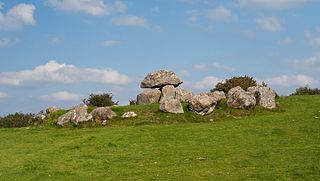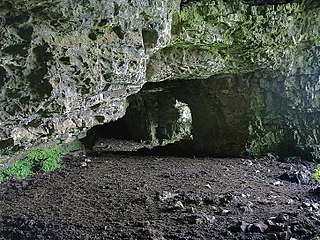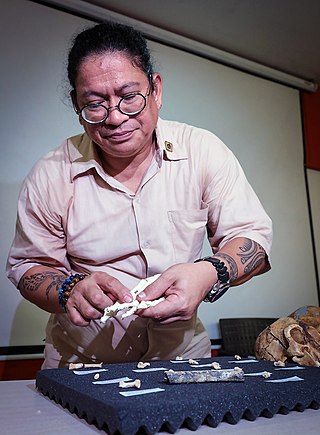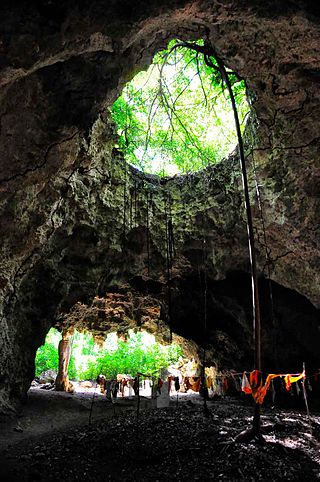Related Research Articles

In archaeology, cave paintings are a type of parietal art, found on the wall or ceilings of caves. The term usually implies prehistoric origin, and the oldest known are more than 40,000 years old and found in the caves in the district of Maros. The oldest are often constructed from hand stencils and simple geometric shapes. More recently, in 2021, cave art of a pig found in Sulawesi, Indonesia, and dated to over 45,500 years ago, has been reported.

Newgrange is a prehistoric monument in County Meath in Ireland, located on a rise overlooking the River Boyne, 8 kilometres (5.0 mi) west of Drogheda. It is an exceptionally grand passage tomb built during the Neolithic Period, around 3200 BC, making it older than Stonehenge and the Egyptian pyramids. It is aligned on the winter solstice sunrise. Newgrange is the main monument in the Brú na Bóinne complex, a World Heritage Site that also includes the passage tombs of Knowth and Dowth, as well as other henges, burial mounds and standing stones.

Carrowmore is a large group of megalithic monuments on the Coolera Peninsula to the west of Sligo, Ireland. They were built in the 4th millennium BC, during the Neolithic. There are thirty surviving tombs, making Carrowmore one of the largest clusters of megalithic tombs in Ireland, and one of the 'big four' along with Carrowkeel, Loughcrew and Brú na Bóinne. Carrowmore is the heart of an ancient ritual landscape which is dominated by the mountain of Knocknarea to the west. It is a protected National Monument.
Margaret W. Conkey is an American archaeologist and academic, who specializes in the Magdalenian period of the Upper Paleolithic in the French Pyrénées. Her research focuses on cave art produced during this period. Conkey is noted as one of the first archaeologists to explore the issues of gender and feminist perspectives in archaeology and in past human societies, using feminist theory to reinterpret images and objects from the Paleolithic Era or the late Ice Age. She is Professor Emerita of Anthropology at the University of California, Berkeley. She was named by Discover magazine in their 2002 article, "The 50 Most Important Women in Science".

Miranda Jane Aldhouse-Green, is a British archaeologist and academic, known for her research on the Iron Age and the Celts. She was Professor of Archaeology at Cardiff University from 2006 to 2013. Until about 2000 she published as Miranda Green or Miranda J. Green.

Azykh Cave, also referred to as Azokh Cave, is a six-cave complex in Azerbaijan, known as a habitation site of prehistoric humans. It is situated near the village of Azykh in the Khojavend District.
Bluefish Caves is an archaeological site in Yukon, Canada, located 54 km (34 mi) southwest of the Vuntut Gwichin community of Old Crow. It has been controversially suggested that human occupation radiocarbon dates to 24,000 years Before Present (BP) based on radiocarbon dating of animal remains, but these dates are contested due to the uncertain stratigraphic context of the archaeological remains relative to the dated animal remains. There are three small caves in the area.
Wonderwerk Cave is an archaeological site, formed originally as an ancient solution cavity in dolomite rocks of the Kuruman Hills, situated between Danielskuil and Kuruman in the Northern Cape Province, South Africa. It is a National Heritage Site, managed as a satellite of the McGregor Museum in Kimberley. Geologically, hillside erosion exposed the northern end of the cavity, which extends horizontally for about 140 m (460 ft) into the base of a hill. Accumulated deposits inside the cave, up to 7 m (23 ft) in-depth, reflect natural sedimentation processes such as water and wind deposition as well as the activities of animals, birds, and human ancestors over some 2 million years. The site has been studied and excavated by archaeologists since the 1940s and research here generates important insights into human history in the subcontinent of Southern Africa. Evidence within Wonderwerk cave has been called the oldest controlled fire. Wonderwerk means "miracle" in the Afrikaans language.
Pendejo Cave is a geological feature and archaeological site located in southern New Mexico about 20 miles east of Orogrande. Archaeologist Richard S. MacNeish claimed that human occupation of the cave pre-dates by tens of thousands of years the Clovis Culture, traditionally believed to be one of the oldest if not the oldest culture in the Americas.
Jan F. Simek is an American archaeologist and educator who was the interim president of the University of Tennessee system from 2009 to 2010.

Kuragala is a pre-historic archaeological site consisting of an early human settlement during the late Pleistocene period and ruins of ancient Buddhist Cave temple complex, dating back to the 2nd century BC, in Balangoda, Sri Lanka. The temple complex is located on the Balangoda - Kaltota road (B38) approximately 24 km (15 mi) distance from the Balangoda town. The site has been formally recognised by the Government as an archaeological reserve in Sri Lanka. Kuragala is considered as the oldest archaeological site found in the Intermediate Zone.

Manot Cave is a cave in Western Galilee, Israel, discovered in 2008. It is notable for the discovery of a skull that belongs to a modern human, called Manot 1, which is estimated to be 54,700 years old. The partial skull was discovered at the beginning of the cave's exploration in 2008. Its significance was realised after detailed scientific analysis, and was first published in an online edition of Nature on 28 January 2015. This age implies that the specimen is the oldest known human outside Africa, and is evidence that modern humans lived side-by-side with Neanderthals. The cave is also noted for its "impressive archaeological record of flint and bone artefacts". Geologically, it is an "active stalactite cave".

The Alepotrypa Cave is an archaeological site in the Mani region of the Peloponnese peninsula. In addition to being inhabited by early farmers, this site was used for burial and cult purposes. Archaeological evidence has revealed that this is one of the largest Neolithic burial sites ever found in Europe. Two adult human skeletons were found at the site from a burial dating to the 4th millennium BC, as well as remains from at least 170 separate persons. Archaeologists are uncertain about the significance of a Mycenaen ossuary, which has been dated to the 2nd millennium BC and appears to have been reburied at Alepotrypa. While there is no direct evidence, it is possible that the ossuary may link Alepotrypa to Tainaron, which was regarded as the entrance to Hades in classical mythology.

The Caves of Kesh, also known as the Keash Caves or the Caves of Keshcorran, are a series of limestone caves located near the village of Keash, County Sligo, Ireland. The caves are situated on the west side of Keshcorran Hill and consist of sixteen simple chambers, some interconnecting.

Armand Salvador B. Mijares is a Filipino archaeologist from Manila, Philippines. He works as Professor of Archaeology at the Archaeological Studies Program of the University of the Philippines-Diliman. He specializes in lithic analysis, ceramic petrology, soil micromorphology, paleolithic archaeology and early human migration in Southeast Asia. In 2010, Mijares gained international attention as the main author of a Journal of Human Evolution report about a 67,000-year old foot bone discovered in Callao Cave. That report gave evidence for the newly named species of Homo, called Homo luzonensis, named after the Philippines' largest island—Luzon. The discovery has advanced the complexity of early human colonization of Southeast Asia.
The Alice and Gwendoline Cave is a limestone cave in County Clare, Ireland. It is known as the site of brown bear bones bearing the mark of butchery, which have pushed back the first known human habitation of Ireland by over two thousand years.
Alma Mekondjo Nankela worked as a specialist at the National Heritage Council of Namibia until 2021. She developed and implemented heritage resource policies and operational guidelines to ensure sustainable utilization and professional conservation. Nankela oversaw the integration of UNESCO's Conventions and other internationally recognized laws into Namibia’s cultural heritage resources systems. She advised the Culture and Heritage Sector on the appropriate measures towards research, conservation, management and promotion of Namibia's cultural heritage resources. She worked closely with local communities to strengthen, encourage and promote their involvement in the preservation and management of their heritage properties. She liaised and collaborated with regional, international heritage professionals and other bodies relating to scientific research and conservation of heritage resources. Her notable scientific and management work is particularly known in the Brandberg, Erongo Mountains, Twyfelfontein World Heritage Site, Spitzkoppe Mountains, Sperrgebiet, Khuiseb Delta, Etosha and Kalahari Basin. She has also assisted the National Museum of Namibia in relations to policy development, preservation, curation and management of archaeological objects, repatriated human remains.
Passage tombs are a category of Megalithic monument from the Neolithic period. They are found in most regions of Ireland but are more prevalent in the Northern half of the island. The usage period of Irish passage tombs date from c. 3750 B.C. to about 2500 B.C. About twenty clusters are recorded in Ireland, but the best known examples are found along a curved trajectory from the west coast to the east, including the centres of Carrowmore and Carrowkeel in County Sligo, and Loughcrew and the Boyne Valley in County Meath.

Kuumbi Cave is an archaeological site located in Kusini District, Unguja South Region of Tanzania. It has been important in determining patterns of human occupation since its formation over 20,000 years ago. Unusual lithic and ceramic finds dated within the last 2,000 years make Kuumbi Cave a unique site. Its name in Swahili, Pango la Kuumbi, translates to "Cave of Creation".
References
- ↑ "Institute of Technology Sligo". IT Sligo. Retrieved 11 October 2017.
- ↑ Moyes, Holley (2012). Sacred Darkness: A Global Perspective on the Ritual use of Caves. University Press of Colorado. ISBN 9781457117503.
- ↑ "New Discovery Pushes Back Date of Human Existence in Ireland by 2,500 years | Irish Archaeology". irisharchaeology.ie. 20 March 2016. Retrieved 11 October 2017.
- ↑ "The Archaeology of Caves in Ireland". www.oxbowbooks.com. Retrieved 11 October 2017.
- ↑ "PRESS RELEASE: 'The Archaeology of Caves in Ireland' wins prestigious Book of the Year award for 2016 - Current Archaeology". Current Archaeology. 3 March 2016. Retrieved 11 October 2017.
- ↑ "The Archaeology of Darkness". www.oxbowbooks.com. Retrieved 11 October 2017.